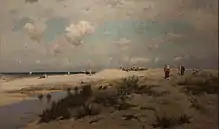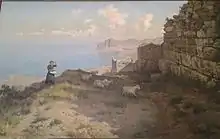Michele Cortegiani
Michele Cortegiani (Palermo, February 8, 1857 - Tunisia, 1928) was an Italian painter, mainly of seascapes of his native Sicily and later Tunisia, and of female portraits and genre subjects.
Michele Cortegiani | |
|---|---|
 Isola delle Femmine, painting by Michele Cortegiani, 1884 | |
| Born | February 8, 1857 Palermo, Italy |
| Died | 1928 |
| Nationality | Italian |
| Education | Francesco Lojacono |
| Known for | Painter |
| Movement | Orientalist |
Biography
_SAM_0420.JPG.webp)
He trained with Francesco Lojacono, moving with him to Paris in 1877–1881.
He assisted with the ceiling decoration (1893-1897) of the Teatro Massimo of Palermo, where he worked alongside Luigi Di Giovanni and Ettore De Maria Bergler, working under the direction of Rocco Lentini.[1] Lentini's concept for the ceiling (pictured) was that of a large wheel with gilded spokes which would contrast with the azure background. Within each spoke, (panels known as petals) feature angels and female figures with musical instruments painted on canvas, while the centrepeice was an allegory of the 'Triumph of Music'. [2]
In later years, he worked in Tunisia, [3][4][5] and in Sicily, along with Lojacono, Michele Catti and other painters of their school, where the group became known as the "masters of colour" because of the way they captured the light of the marinas and sleepy villages of Sicily.[6]

See also
References
- "Teatro Massimo," Italian Ways, Italian Ways; Utopiam, T., L'Arte a Napoli: La Scuola di Posillipo, Lulu.com, 2017, p. 20 (translated from Italian); "Teatro Massimo," in I Luoghi della Musica, Touring Editore, 2003 p. 259
- Lynn, C.K., Italian Opera Houses and Festivals, Scarecrow Press, 2005, p. 309
- Galleria Roma. entry on Cortegiani.
- Dizionario degli artisti italiani viventi, pittori, scultori e architetti, by Angelo De Gubernatis, Ugo Matini, page 143-144.
- Garollo, Gottardo (1907). Ulrico Hoepli (ed.). Dizionario biografico universale. Editore Libraio della Real Casa, Milan. p. 585.
- Quatriglio, G., Sicily: Island of Myths, Legas/Gaetano Cipolla, 2011, p. 11